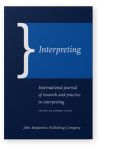Vol. 24:1 (2022) ► pp.38–58
Listeners’ perception of the quality of simultaneous interpreting and perceived dependence on simultaneous interpreting
With the rise of the use of English as a lingua franca (ELF), the number of conference speakers and attendees who use English is increasing. Simultaneous interpreting (SI) into and from English may be provided at conferences to meet the needs of individuals with differing levels of English ability. This paper reports on the findings obtained from two sets of experiments that explored the link between listeners’ perceived dependence on SI and their perceptions of its quality. The first set of experiments was conducted onsite and the second using a remote simultaneous interpreting (RSI) setting. Native Hong Kong Cantonese-speaking participants were divided into two groups: one with Russian as the source language (SL) (Russian group) and the other with English as the SL (English group). Both groups listened to the same prerecorded simultaneous interpretation into Cantonese performed by a non-native interpreter. In the onsite setting, the Russian group perceived the non-native-accented interpretation more favorably than the English group did. This suggests that in onsite settings, perceived dependence on SI may be associated with perceptions of its quality; the greater the perceived dependence on SI, the higher the perceived SI quality. However, no significant differences were found between the two groups in the RSI setting. Factors such as the inaudible SL in the background, similar levels of perceived dependence, negative feelings about online learning and tensions in the state-society relationship may contribute to the similar quality perception ratings across the two RSI groups.
Article outline
- English as a conference language
- Listeners’ dependence on SI
- Listeners’ perceptions of the quality of SI
- Listeners’ perceptions of remote SI
- Experiment 1
- Participants
- Materials
- Procedure
- Results
- Discussion
- Experiment 2
- Participants
- Materials and procedure
- Results
- Discussion
- Conclusion
-
References
